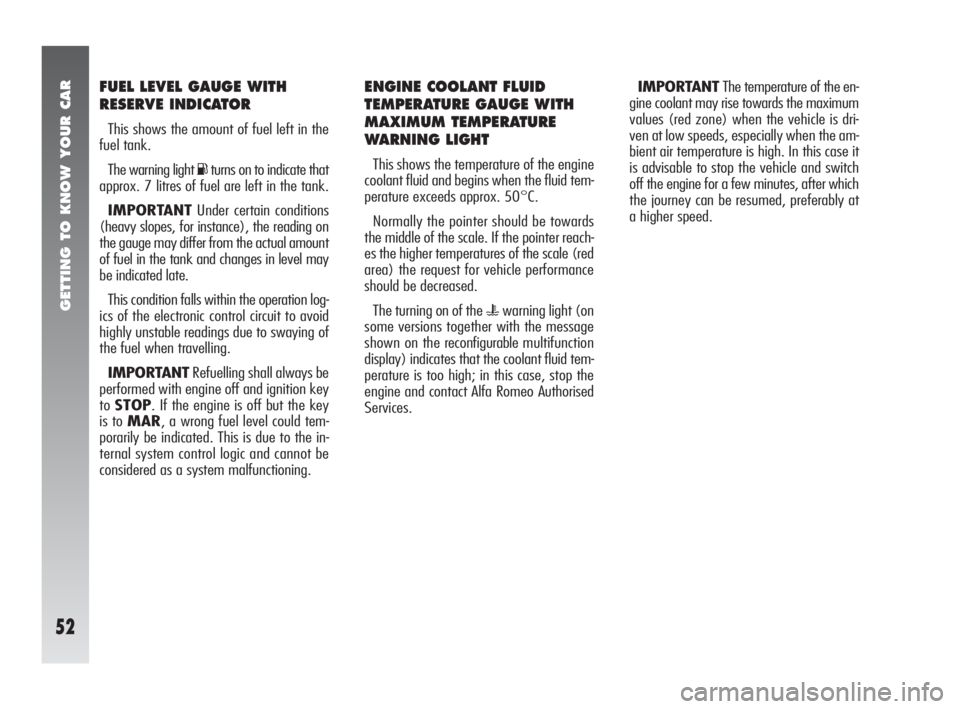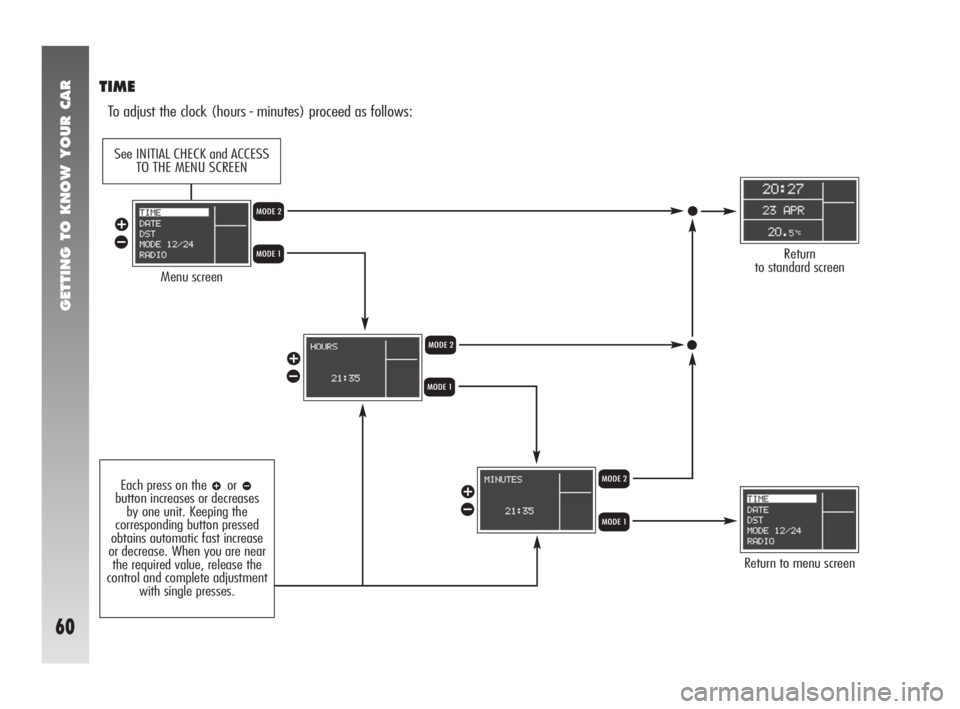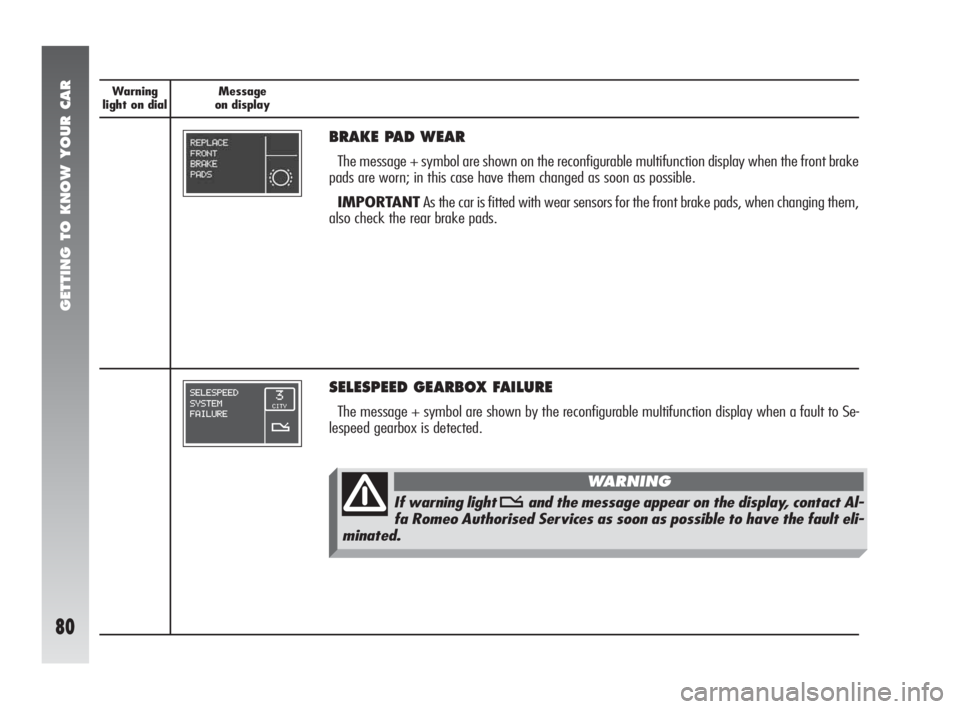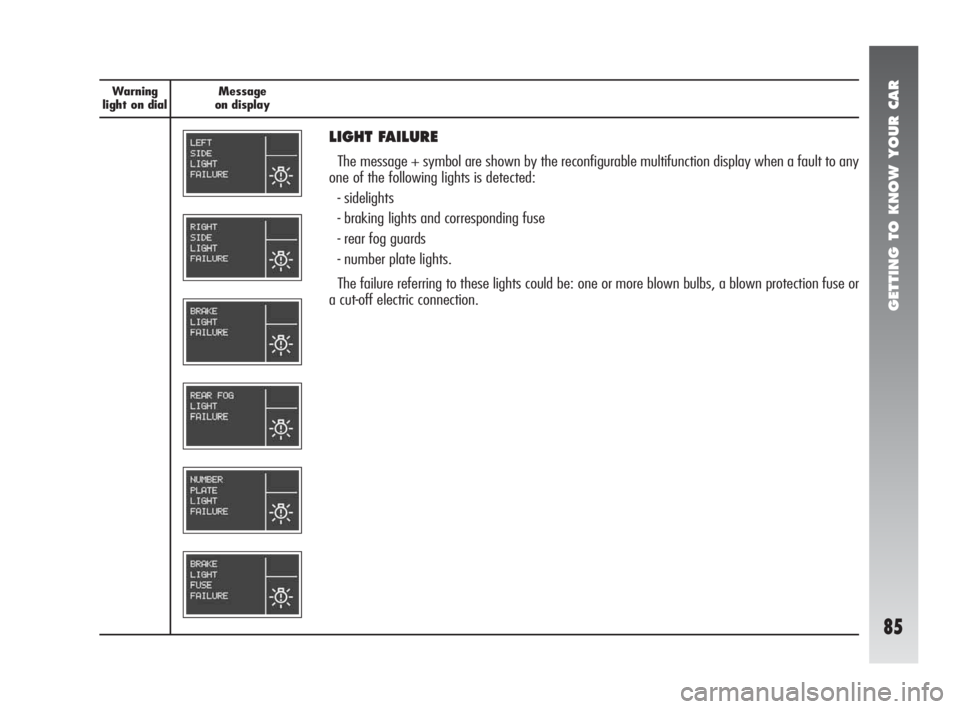ESP Alfa Romeo 147 2005 Owner handbook (in English)
[x] Cancel search | Manufacturer: ALFA ROMEO, Model Year: 2005, Model line: 147, Model: Alfa Romeo 147 2005Pages: 291, PDF Size: 5.52 MB
Page 54 of 291

GETTING TO KNOW YOUR CAR
52
IMPORTANTThe temperature of the en-
gine coolant may rise towards the maximum
values (red zone) when the vehicle is dri-
ven at low speeds, especially when the am-
bient air temperature is high. In this case it
is advisable to stop the vehicle and switch
off the engine for a few minutes, after which
the journey can be resumed, preferably at
a higher speed.ENGINE COOLANT FLUID
TEMPERATURE GAUGE WITH
MAXIMUM TEMPERATURE
WARNING LIGHT
This shows the temperature of the engine
coolant fluid and begins when the fluid tem-
perature exceeds approx. 50°C.
Normally the pointer should be towards
the middle of the scale. If the pointer reach-
es the higher temperatures of the scale (red
area) the request for vehicle performance
should be decreased.
The turning on of the
uwarning light (on
some versions together with the message
shown on the reconfigurablemultifunction
display) indicates that the coolant fluid tem-
perature is too high; in this case, stop the
engine and contact Alfa Romeo Authorised
Services.
FUEL LEVEL GAUGE WITH
RESERVE INDICATOR
This shows the amount of fuel left in the
fuel tank.
The warning light
Kturns on to indicate that
approx. 7 litres of fuel are left in the tank.
IMPORTANTUnder certain conditions
(heavy slopes, for instance), the reading on
the gauge may differ from the actual amount
of fuel in the tank and changes in level may
be indicated late.
This condition falls within the operation log-
ics of the electronic control circuit to avoid
highly unstable readings due to swaying of
the fuel when travelling.
IMPORTANTRefuelling shall always be
performed with engine off and ignition key
toSTOP. If the engine is off but the key
is to MAR, a wrong fuel level could tem-
porarily be indicated. This is due to the in-
ternal system control logic and cannot be
considered as a system malfunctioning.
Page 55 of 291

GETTING TO KNOW YOUR CAR
53
RECONFIGURABLE MULTIFUNCTION DISPLAY
The reconfigurable multifunction display is
able to display all the useful and necessary
information when driving and a menu allows
the following adjustments and/or settings:
TIME
DATE
OUTSIDE TEMPERATURE
INFORMATION ABOUT VEHICLE CONDITION
- Trip computer
- Lighting adjustment (rheostat)
- Display of failure messages with corre-
sponding symbol
- Display of warning messages with cor-
responding symbol (e.g.: possible ice on
road)Reconfigurable multifunction
display menu
SPEED
- Activation/deactivation of the corre-
sponding indication (ON/OFF)
- Setting the speed limit
TRIP B
- Activation/deactivation of the corre-
sponding function (ON/OFF)
TIME
- Setting the hours
- Setting the minutes
DATE
- Setting the day
- Setting the month
- Setting the year
DST (SUMMER TIME)
- Activation/deactivation of summer time
MODE 12/24
- Selecting the clock mode on 12 or 24
hours
RADIO
- Activation/deactivation of the following
items on the display:
frequency or RDS message of the radio
station selected, compact disc and cor-
responding track selected, cassette func-
tion onTELEPHONE
- Activation/deactivation of the following
items on the display: incoming or out-
going phone call with name and/or
number of the subscriber connected
NAVIGATION
- Activation/deactivation of the displays
and information concerning the route to
be followed
LANGUAGE
- Setting the language of the messages
shown on the display
UNITS
- Selection of the following units of mea-
sure: km, mi, °C, °F, km/l, l/100km,
mpg
BUZZER
- Buzzer volume adjustment
SERVICE
- Display of information concerning correct
vehicle maintenance, strictly connected
with the Scheduled Maintenance Pro-
gramme
MENU OFF
- Exits the menu.
Page 57 of 291

GETTING TO KNOW YOUR CAR
55
MENU OFF
SPEED
TRIP B
TIME
DATE
DST (SUMMER TIME)
MODE 12/24
RADIO TELEPHONE NAVIGATIONLANGUAGEUNITSBUZZERSERVICE
DESCRIPTION OF THE MENU
The menu comprises a series of functions arranged in a “circular fashion”, which can be selected through the âandãbuttons for access
to the different select operations and settings (see examples “LANGUAGE” and “DATE” below); for further details, also refer to “Access to the
menu screen” in the previous chapter.
Day
YearMonth
Q
Q
Français
Deutsch
Nederlands
Italiano
Español
English
Page 62 of 291

GETTING TO KNOW YOUR CAR
60
TIME
To adjust the clock (hours - minutes) proceed as follows:
Menu screen
Return to menu screen
Return
to standard screenQ
Q
Q R
R
R
â
ã
â
ã
â
ã
See INITIAL CHECK and ACCESS
TO THE MENU SCREEN
Each press on the âorãbutton increases or decreases
by one unit. Keeping the
corresponding button pressed
obtains automatic fast increase
or decrease. When you are near
the required value, release the
control and complete adjustment
with single presses.
Page 63 of 291

GETTING TO KNOW YOUR CAR
61
DATE
To correct the date (day - month - year) proceed as follows:
Menu screen
Return to menu screen
Return
to standard screenQ
Q
Q
Q R
R
R
R
â
ã
â
ã
â
ã
â
ã
Each press
on the
âorãbutton increases
or decreases by
one unit. Keeping the
corresponding
button pressed obtains automatic
fast increase or decrease. When
you are near the required value,
release the
control and complete adjustment
with single presses.
See INITIAL CHECK and ACCESS
TO THE MENU SCREEN
Page 64 of 291

GETTING TO KNOW YOUR CAR
62
DST (SUMMER TIME)
To activate/deactivate the summer time function (which corresponds to + 1 hour in relation to the daylight time), proceed as follows:
Menu screen
Return to menu screen
Return
to standard screen
Selecting and activating the
DST ON function,
the display switches from
daylight time to summer time
and vice versa, with no need
to intervene manually
on the TIME function described
previously.
Q
Q R
R
â
ã
â
ã
See INITIAL CHECK and ACCESS
TO MENU SCREEN
Page 82 of 291

GETTING TO KNOW YOUR CAR
80
Warning
light on dialMessage
on display
BRAKE PAD WEAR
The message + symbol are shown on the reconfigurable multifunction display when the front brake
pads are worn; in this case have them changed as soon as possible.
IMPORTANTAs the car is fitted with wear sensors for the front brake pads, when changing them,
also check the rear brake pads.
SELESPEED GEARBOX FAILURE
The message + symbol are shown by the reconfigurable multifunction display when a fault to Se-
lespeed gearbox is detected.
If warning light tand the message appear on the display, contact Al-
fa Romeo Authorised Services as soon as possible to have the fault eli-
minated.
WARNING
Page 87 of 291

GETTING TO KNOW YOUR CAR
85
Warning
light on dialMessage
on display
LIGHT FAILURE
The message + symbol are shown by the reconfigurable multifunction display when a fault to any
one of the following lights is detected:
- sidelights
- braking lights and corresponding fuse
- rear fog guards
- number plate lights.
The failure referring to these lights could be: one or more blown bulbs, a blown protection fuse or
a cut-off electric connection.
Page 90 of 291

GETTING TO KNOW YOUR CAR
88
Warning
light on dialMessage
on display
MAIN BEAMS
The warning light on the dial turns on when the main beams are turned on or when the “Follow
me home” device is turned on (see corresponding chapter).1
WARNING LIGHT FAILURE
This is shown on the reconfigurable multifunction display when a fault is detected to one of the
warning lights indicated.
POSSIBLE PRESENCE OF ICE ON THE ROAD
The symbol √+ message are shown by the reconfigurable multifunction display and the buzzer
sounds, when the outside temperature reaches or falls below 3°C to warn the driver of the possi-
ble presence of ice on the road.
Page 97 of 291

GETTING TO KNOW YOUR CAR
95
AIR TEMPERATURE
ADJUSTMENT KNOBS
(fig. 78)
Turning the rings of knobs (2or6), clock-
wise or counter-clockwise, respectively high-
ers or lowers the temperature of the air re-
quired respectively in the left zone (knob 2)
or right zone (knob 6) of the passenger
compartment. The temperatures set are
shown on the displays (1) and (5) above
the knobs.
Separate operation of the temperatures set
is restored automatically using knob (6).
Turning the knob rings clockwise or
counter-clockwise until they reach the ex-
treme selections HIorLO, the maximum
heating or cooling functions are respective-
ly engaged:
A0A0204m
fig. 78